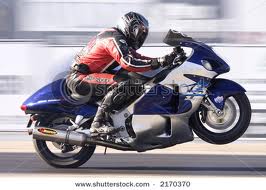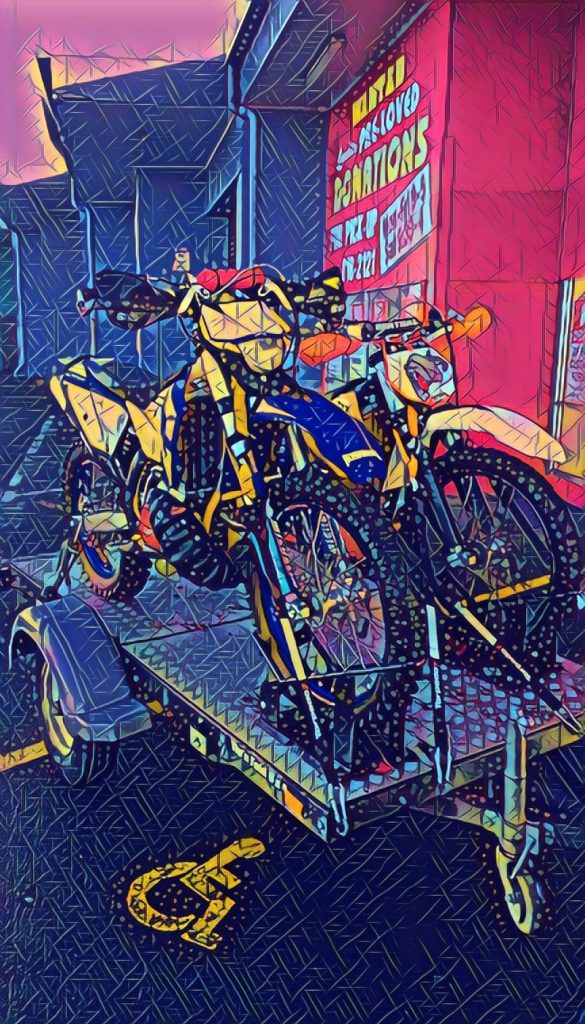
The Back Brake
Oh the back brake, what a wonderful example of there is more to a control than its primary effect or purpose. Good old Newton is all over the back brake.
So one could think that the primary purpose of a back brake is to slow you down and although it is good at this, especially on a bike that managed to keep weight onto it, its effectiveness drops a lot once that weight comes off.
But that DOES NOT MEAN the back brake should be avoided. Because it’s other effects can be wonderful things for your repertoire of twiddly bits for controlling the wobbly bits.
Ok, so let’s look at how the damn thing affects the bike. We already know how brakes work right so we just need to know what is different with the back brake.
Well for a start, where as the front brake tries to pull the bike up and over the front wheel the back brake tries the complete opposite. It wants to pull the bike down onto the road. Of course you can see because you are getting all Newtonian literate on me now right, that in order to do that it must twist the swing arm (thing that holds the back wheel) down and that would mean compressing the rear shock absorber so bringing more stability to the rear.
Also, because of its leverage point being right at the back of the bike it does not compress the front suspension that much which means it doesn’t change the trail so much, or in English the bikes turning circle inherent in the geometry whilst it slows down the speed.
Secondly it can be used to oppose the engines attempts to turn the back wheel, working like a sort of power damper.
Keep it on the ground

So when you are really starting to lay down power and the front keeps popping up and interfering with your fun, I wonder what would happen with the gentle application of a little back brake?
Yep you got it, front comes down. You don’t even have to back off (brakes wear out anyway right!!). So those really fast exiting corners where you get a little air, or that bump in the back straight you hit under full acceleration and launch the front, nudge it back down with a little back.
Keep it from spinning too much
What about its ability to work against the engine. We’ll something to be used judiciously, but if you spin up the back and then back off the throttle you will end up with some sudden grip and possibly a lesson in low level flying. If you just back off slightly you never know how much is enough to stop the spinning of the motor into still higher revs and therefore power and how much is too little and will launch you into low orbit.
Again a gentle dip on the rear brings about a couple of interesting effects. Firstly it works against the engine and provides sort of unnatural grip slowing the amount of wheel spin whilst not easing back on the power. Secondly it slows the progression of the revs and thus brings the air pump under control and lastly it adds traction by squatting the back and putting more pressure on the tire.
All this without backing off and there is another little thing that is nice to know.. if you over do it and lock the back you are in a slide and can back off the brake and recover spinning with the power off. Still safer, especially if you know how to dirt track.
This might explain a technique I was taught a long time ago that when you spun up the back you should lock the brake and close the throttle then ease off the brake and get back onto throttle. I was never game enough to try this technique in anger but have used the brake against engine on more than few occasions with great success.
Anyone remember the thumb brake?
Trailing brake?
Now how often have you got into a corner and thought I really should have let go of the brakes a ways back, and then spend a while in a nervous state of wonderment at your tires ability to forgive you?
We know now that trailing the front brake into a corner is a very risky business and more so because it loads up the front forks it shortens your trail and therefore makes your bike want to sit up and go straight ahead. Combine this with your desire to turn means you just demand even more of your tire.
So it’s a very advanced technique to say the least. But what if you need to slow down because you have gone into the corner to hot and you really would like the tension that has arrived in your gut to go away and NOW!!
Well the back brake can slow you down and not stand the bike up in the middle of the corner and if you over power it a rear slide in the corner is more controllable than a front for us mere mortals.
So brake of choice for mid corner stress outs, oh and leave the front alone in the corners!!!
Encouraging a SET
So we are hopefully getting the idea that the transition phase from set to set is our most important phase to manage. Sports bikes are firmly sprung and have pretty well controlled suspension which can mean that a transition phase is already reasonably under control and also can be encouraged to move through the transition pretty quickly.
Some bikes, like cruisers or tourers are less firmly sprung and have geometry that does not encourage a quick transition. The back brake can help out here a lot because getting a “Set” is usually about getting the bike compressed onto the road in a stable manner and we already know that applying the back brake does this.
Now this is NOT about jumping on the back brake but about the transitions. So for an example when you are braking hard before a corner and then let go of the brakes and turn into the corner your sports bike will transition like it has just crested a small hill lifting on the suspension and quickly compressing again with the corner force. But your cruiser will not do this quickly and if you are wanting to get through the corner faster than the bike will settle then keep it settled by keeping a little back brake on until after you have turned and got the corner “set”. This will keep the bike squatted throughout and keep you stable.
Just remember we are not talking about trailing rear brake, you want to let the brake go the moment you are heeled over and turning.
Really slow corners

So this one is a little left field but you probably will go “WOW” the first time you try it.
In slow speed handling, like a lock to lock figure of 8 balancing the brake against the throttle and clutch is a recipe for a lot of wobbling.
What would happen if you could use the throttle locked in position and the clutch locked into a position that was slipping a little and then the back brake to control your speed? More back brake less speed, less back brake more speed.
Try it, you’ll find you can do lock to lock turns like a pro. Just remember you are riding the clutch so don’t practice for hours on end, heat kills clutches.
I personally can do a full lock turn with a pillion on a sports bike and don’t consider that I am particularly well balanced, just ask my psychiatrist. It works trust me.
(P.S. if your practicing the above the biggest thing you will have to break is that habit of fully engaging the clutch and letting the Revs drop)



